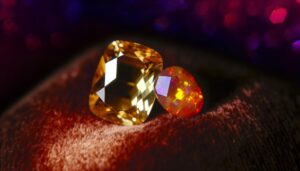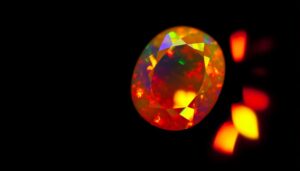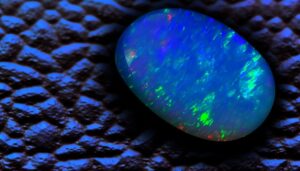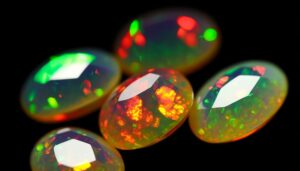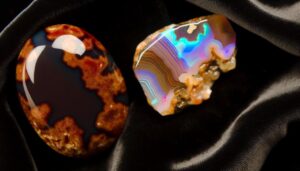What Do Fire Opals Look Like Visually?
You'll find fire opals mesmerizing with their vibrant hues of red, orange, and yellow. These colors arise from diffraction of light in silica spheres.
Fire opals usually display a vitreous luster with surface textures ranging from smooth to slightly pitted. Their transparency varies from opaque to highly translucent, often influenced by internal mineral inclusions which scatter light.
Commonly cut into cabochons, these gemstones highlight their unique play-of-color. Sizes range from small millimeter stones to larger carat specimens, each differing in thickness and dimensions.
If you're intrigued by their unique qualities, there's much more to uncover.
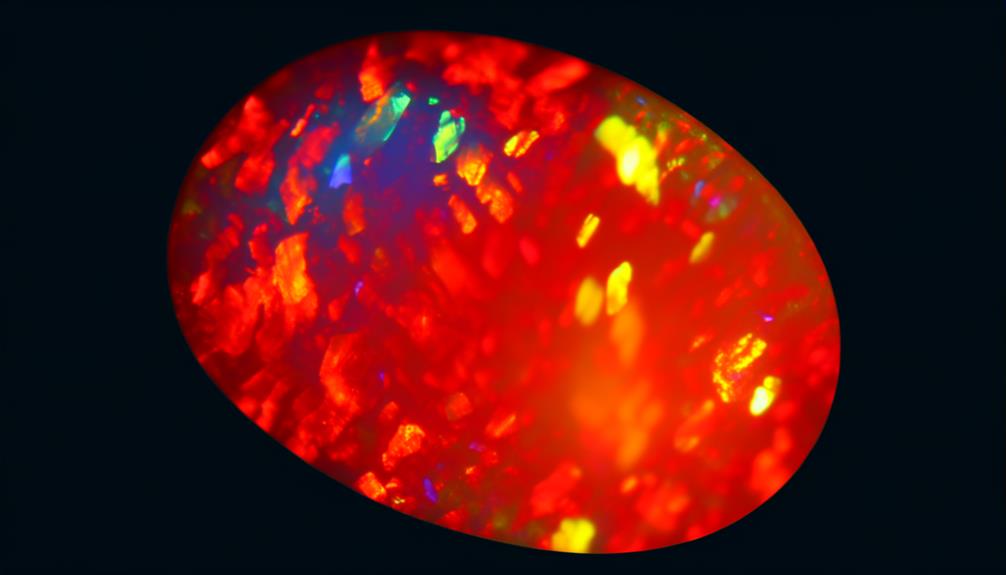
Key Takeaways
- Fire opals display vibrant hues of reds, oranges, and yellows due to light diffraction in silica spheres.
- The stones range from opaque to highly translucent, affecting their clarity and brilliance.
- Cabochon cuts are popular to showcase the opals' play of color and fiery brilliance.
- Fire opals have a glass-like, vitreous luster with occasional surface imperfections like microscopic pits.
- Larger fire opals are ideal for statement pieces, while smaller ones suit intricate designs.
Color Spectrum
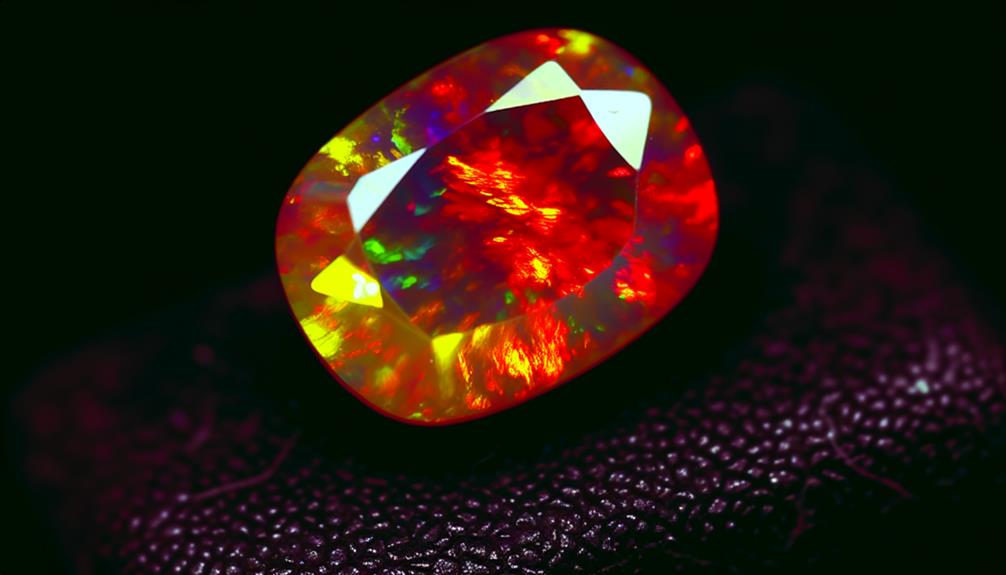
When analyzing the color spectrum of fire opals, you'll note that these gemstones exhibit a vibrant range of hues, primarily dominated by fiery reds, oranges, and yellows. The chromatic intensity results from the diffraction of light within the microscopic silica spheres that constitute the opal's structure.
This diffraction causes a play-of-color effect, where wavelengths of light are split into individual colors, generating a dynamic visual display. The reds and oranges are often more intense due to the larger sphere sizes, which reflect longer wavelengths of light. Additionally, the yellows emerge from medium-sized spheres.
Understanding this interplay of light and silica composition allows you to appreciate the complex beauty and fiery brilliance of these unique gemstones.
Transparency and Clarity
When examining fire opals, you'll notice that their transparency ranges from completely opaque to highly translucent, greatly affecting their overall appearance.
Internal inclusions, such as mineral deposits or fractures, can further influence the gem's clarity and brilliance.
Additionally, surface imperfections like scratches or pits may detract from the fire opal's visual allure and value.
Degree of Transparency
Fire opals exhibit a range of transparency levels, from completely opaque to perfectly transparent, greatly impacting their overall clarity and brilliance. You'll find that the degree of transparency affects how light interacts with the gemstone. Transparent fire opals allow light to pass through almost unobstructed, creating a vivid play of color. Translucent stones diffuse light, resulting in a softer, more subtle glow. Opaque fire opals, on the other hand, don't allow light to penetrate, giving them a more solid appearance. Understanding these transparency variations helps in evaluating their visual appeal and market value.
| Transparency Level | Light Interaction | Visual Effect |
|---|---|---|
| Transparent | Unobstructed | Vivid play of color |
| Translucent | Diffused | Soft, subtle glow |
| Opaque | None | Solid appearance |
Internal Inclusions
Understanding the degree of transparency in fire opals naturally leads to examining their internal inclusions, which greatly influence the gemstone's clarity and overall visual appeal.
Inclusions are tiny impurities or structural anomalies within the opal, such as gas bubbles, mineral deposits, or fractures. These inclusions can scatter light, diminishing the opal's brilliance and affecting its transparency. High-quality fire opals exhibit minimal inclusions, resulting in a clearer, more vibrant appearance.
Conversely, significant inclusions can create a cloudy or milky look, reducing the gemstone's market value. By using a loupe or microscope, you can identify these inclusions and assess their impact on the gem's clarity. Understanding inclusions is essential when evaluating fire opals for both beauty and worth.
Surface Imperfections
Surface imperfections greatly influence a fire opal's transparency and clarity, often manifesting as scratches, pits, or abrasions that detract from the gem's overall visual quality. You'll notice that even minor surface flaws can scatter light unevenly, reducing the stone's brilliance and fire.
Scratches, for instance, create tiny valleys that diffuse light. Pits and abrasions further disrupt the surface, making the opal appear cloudy or dull. When evaluating fire opals, pay close attention to these imperfections.
High-quality fire opals exhibit minimal surface flaws, ensuring maximum light transmission and vivid color play. Proper cutting and polishing techniques are essential to minimizing these defects, thereby enhancing the gemstone's aesthetic and market value.
Common Shapes
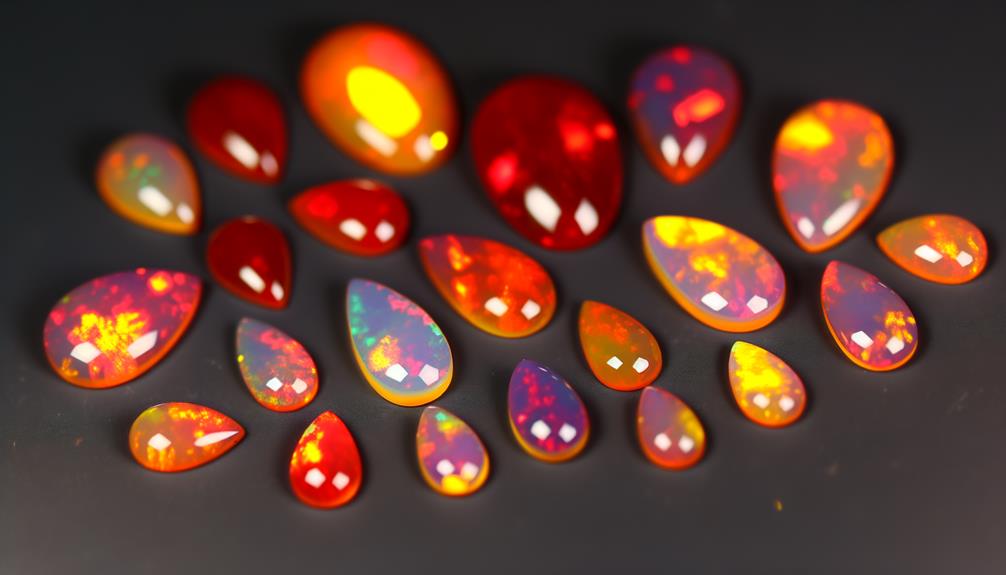
When exploring common shapes of fire opals, you'll find that cabochon cuts are particularly popular due to their ability to showcase the stone's vibrant play of color.
Each region exhibits distinct shape preferences, with some favoring oval or round cuts while others opt for freeform shapes to maximize carat weight.
Understanding these preferences helps you appreciate the global diversity in fire opal presentation.
Popular Opal Cuts
In the world of fire opals, you'll often encounter popular cuts like the oval, round, pear, and marquise, each meticulously chosen to enhance the gem's fiery brilliance and color play.
The oval cut, with its elongated shape, maximizes light reflection, intensifying the opal's vibrant hues.
The round cut, a classic choice, offers balanced symmetry, ensuring even color distribution.
Pear cuts combine the elegance of a teardrop shape with best light dispersion, accentuating the gem's fire.
The marquise cut, with its elongated, pointed ends, creates a dramatic effect, emphasizing the opal's unique patterns.
Each cut is strategically selected to highlight the intrinsic beauty of fire opals, ensuring maximum visual impact and appeal.
Shape Preferences Worldwide
Have you ever wondered why certain opal shapes dominate specific markets, reflecting both cultural preferences and aesthetic priorities? When you examine the global market, you'll find that round, oval, and teardrop shapes are particularly favored for their symmetry and balance.
| Region | Preferred Shape | Cultural Significance |
|---|---|---|
| North America | Oval | Symbolizes unity and infinity |
| Europe | Round | Represents completeness and eternity |
| Asia | Teardrop | Evokes emotions and fluidity |
In North America, ovals are prized for their visual harmony and versatility in jewelry design. Europe leans towards round shapes, which are seen as timeless and elegant. Meanwhile, in Asia, teardrop shapes are beloved for their graceful curves and emotional resonance. These preferences underscore the fusion of aesthetics and cultural values in gemstone markets.
Surface Texture
The surface texture of fire opals is characterized by its vitreous luster, smooth to the touch yet occasionally exhibiting microscopic pits and irregularities.
When you closely inspect a fire opal, you'll notice its glass-like finish, reflecting light brilliantly. This luster is due to its high silica content.
Despite its general smoothness, some fire opals may show minute surface imperfections, such as tiny pits or inclusions, which are natural and not considered flaws. These features can add to the stone's unique appeal.
You should also be aware that fire opals are relatively soft, ranking 5.5 to 6.5 on the Mohs scale, making them susceptible to scratching. Handle them with care to maintain their pristine surface texture.
Size and Weight
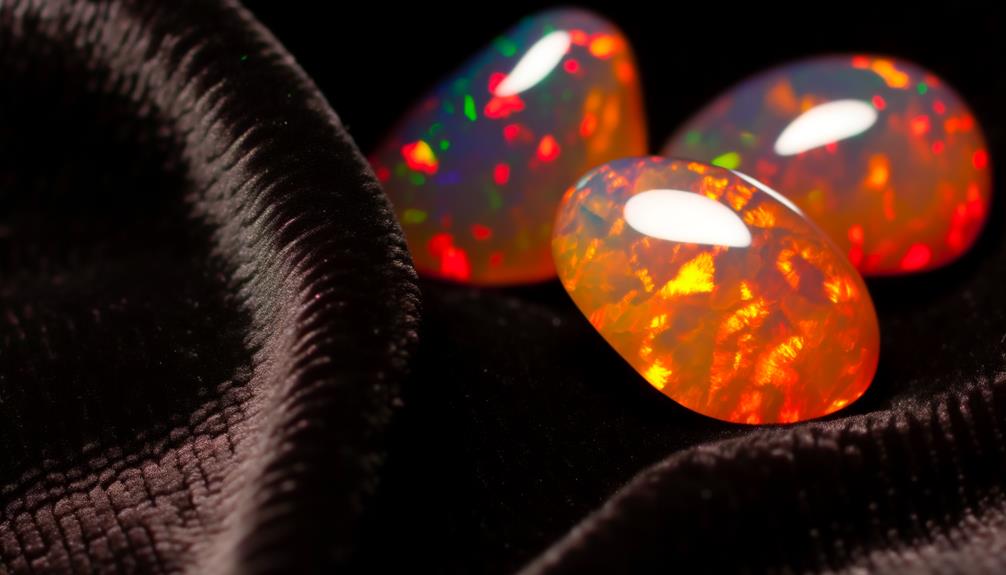
While appreciating the fire opal's smooth, glassy surface, you'll also need to assess its size and weight, which greatly influence its value and application in jewelry. Fire opals vary significantly in size, ranging from small millimeter-sized stones to larger specimens over several carats.
Weight, measured in carats, directly correlates with both size and value, as larger stones are rarer and more sought after. Precision in carat measurement is vital; even slight variations can impact pricing. When evaluating, consider thickness and dimensions, as these affect setting options.
Larger, well-balanced fire opals are ideal for statement pieces, while smaller ones are perfect for intricate designs. Always use calibrated tools to guarantee accuracy in your assessments.
Quality Indicators
Evaluating the quality of fire opals involves examining their color play, clarity, cut, and transparency, each contributing to the stone's overall aesthetic and market value.
You'll first look at the color play, which refers to the vibrant flashes of color within the stone. High-quality fire opals exhibit intense, vibrant hues.
Clarity is another essential factor; fewer inclusions and blemishes make the opal more desirable.
The cut should enhance the stone's natural beauty, maximizing its color play and brilliance.
Finally, transparency ranges from opaque to translucent. Translucent fire opals with a deep, uniform body color are generally more valued.
Conclusion
In examining fire opals, you've journeyed through a vibrant color spectrum, noted their diverse transparency and clarity, observed common shapes, and scrutinized their surface texture, size, and weight.
These gems, akin to fiery sunsets captured in stone, reveal their highest quality through vivid hues and minimal inclusions.
Understanding these indicators guarantees you can discern and appreciate the finest fire opals, making your gemstone selections both informed and exceptional.

